Garden Cyclamen
by Derek Burch
Enjoying florist's cyclamen scarcely scratches the surface of the pleasures to be had from this intriguing genus. To a plantsman, they are curious members of the primrose family, looking very little like their familiar relatives. To a botanical specialist, and to a cyclamen enthusiast, they are an easily recognisable group with many fascinating features.
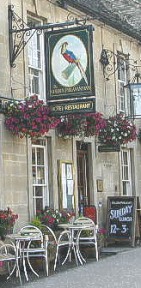
There are about 20 species in the genus, of which half a dozen are fairly
common, and the rest 'collector's items'. All of these plants are from
the Mediterranean area, extending into southern Europe in the north of
the range and Iran and Somalia to the south. One species, Cyclamen
hederifolium has escaped from cultivation in Great Britain, and is
found in places where no gardens have existed in recent history.
Cyclamen have been overcollected from many parts of their range, and there are finally some restrictions being enforced. Gardeners are asked to check that plants which they buy are not wild-collected to assist in controlling the illegal trade in these and many other bulbous plants. The commoner species will seed quite freely in cultivation, and form a saleable plant in a couple of seasons, with a well-developed storage structure.
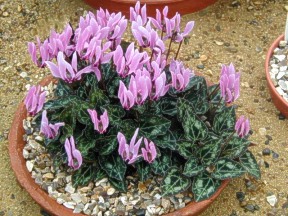 |
The petals which turn back from the centre of the flower are the most obvious feature that these plants have in common. Only Dodecathon shares this feature so prominently in the primrose family, although other unrelated plants draw their names from a similarity - Narcissus cyclamineus, for example, has the petals reflexed, and the species name reflects this unusual way in which the petals of cyclamens are also held. |
|
Cyclamen
hederifolium in full bloom
|
The storage structure also has
a common origin through the genus, but it is a strange part of the plant
to have this storage function, and leads to disagreements in botanical
circles as to the proper name - tuber or corm? - probably neither is strictly
correct, but let's leave the botanists to argue that one out. In nature
these may form above ground like those of the florist's cyclamen, with
roots mostly from the bottom, or may be buried shallowly with roots from
the top or all over in various other species.
| In the temperate garden, cyclamen are most commonly used in a woodland setting.A good rule of thumb for planting is to put the tuber with the top at soil level and then add some coarse grit over the top. A build up of leaf mould from fallen leaves does not seem to be harmful once the plants are established. They tend to be dormant and leafless through the summer, and may produce flowers before the first leaves reappear in autumn. |
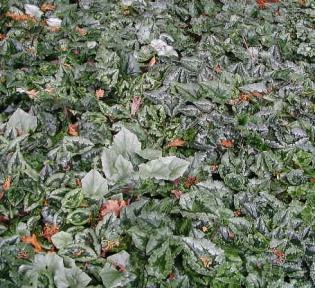 |
|
A
bed of Cyclamen
hederifolium
|
The length of the flowering season depends on the species and on weather conditions, but usually lasts two to three months. If the flowers set seed, the stalk coils on itself, drawing the developing fruit into the centre of the plant. The capsule eventually splits open when the seeds are ripe, and there may be some dispersal of the seed by ants.
Cyclamen enthusiasts often grow the plants in pots so as to be able to control the water that the plants receive. There are spectacular fall displays in various alpine houses of botanical gardens such as Kew and Wisley, where plants from several species with marbled leaves have been selected to illustrate the range of possible forms and markings. And these are only a small selection of the apparently infinite range.
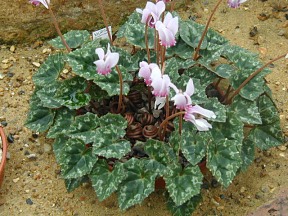 |
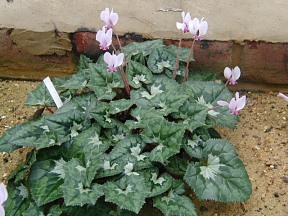 |
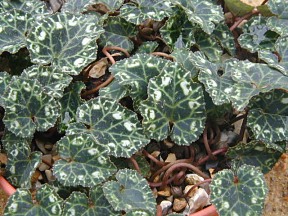 |
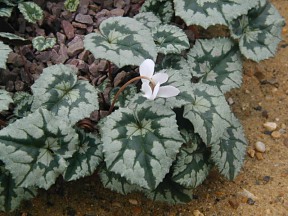 |
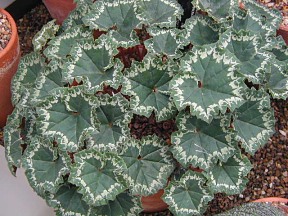 |
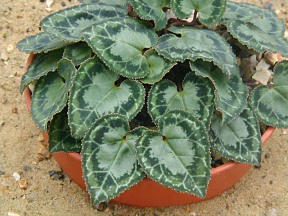 |
|
A
sampler of the range of leaf marbling found in Cyclamen
hederifolium
|
|
|
|
|
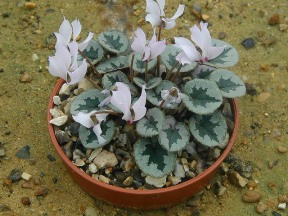 |
Cyclamen mirabile is a very cold-hardy species. Mature leaves will go limp after a frost but soon recover. Some forms have a reddish cast over the silver of the variably marbled, but always attractive, leaves. |
| Cyclamen graecum is one of several species that will pull themselves into the soil with contractile roots, thus setting their own planting depth. The leaf marbling is extremely variable. This species may prefr a more open site with good sun exposure in summer as long as the persistent roots can be in slightly moist soil. |
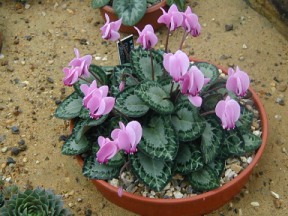 |
Cyclamen hederifolium is by far the most frequently encountered species, but others can be found, and not only in specialist nurseries. There is a thriving society of enthusiasts, which has sponsored several collecting trips, adding material for study and distribution to gardens. They have a website that covers all aspects of growing, and is a fascinating trip in itself. Visit this at http://www.cyclamen.org/indexCS.html
Back to Table of Contents